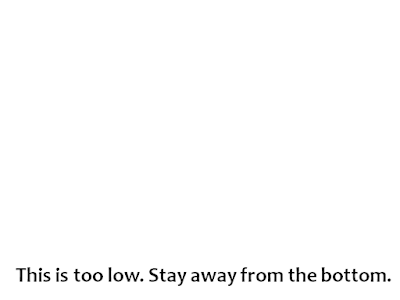
 Are you looking for a presentation designer? I've been asked so many times if I could recommend a presentation designer that I've decided to publish a list of PowerPoint and Keynote slide design companies and freelancers. I asked each presentation designer to talk about their approach to presentation design and to give me an example of a slide that represents their brand.
Are you looking for a presentation designer? I've been asked so many times if I could recommend a presentation designer that I've decided to publish a list of PowerPoint and Keynote slide design companies and freelancers. I asked each presentation designer to talk about their approach to presentation design and to give me an example of a slide that represents their brand.
I've used a very traditional method to order these presentation designers – it's alphabetical based on the principal's last name.
You'll see a tremendous variety in approaches – from business focus, to scientific rigor to aesthetics.
Rick Altman, Better Presenting
There are plenty of PowerPoint trainers in the world. There is also no shortage of speaking coaches. And finding a marketing consultant to help with message and branding is not terribly difficult. But finding a consultant with demonstrated expertise in all of these critical areas of presentation is not so common. Rick Altman is one of the few in the presentation community who blends presentation design, best practices, and software technique to serve his clients.
This finished slide, for the largest insurance provider in the United States, began as a typical slide, with far too many words, no white space, and no visual focus (text is greeked to respect company privacy). Pairing down the text to hone the message is just the first part of the solution; integrating an evocative visual is critical to giving the message its emotional weight. Finally, using PowerPoint's support for semi-transparency allows the text and the image to be blended into a single story.

Claudia Bennett, Cestudio Design
The best presentation has the speaker's message simple and right to the point and educates the audience in the subject message matter while keeping the story line alive. Like a good movie! I feel privileged to count myself as one of the few presentations designers worldwide able to work in both English and Spanish. I'm based in Boston, Massachussets, USA.

Chantal Bossé, CHABOS
I have a passion for visual communications. Since I created CHABOS in 2004, my main goal has been to help entrepreneurs, trainers and speakers improve their presentations and performance with a real "visual communication" tool.
To convince audiences we need more than just pretty slides; we need a convincing and inspiring message! My approach to help clients set themselves apart from the crowd: flexible presentations. It gives them the possibility to tailor their message to the audience's needs on the spot. It does take more time, and of course practice to master content structure and the use of the technology. But presenters willing to go that route have a memorable impact on audiences. Some clients have even increased their sales with this presentation method, and greatly reduced the need to design new slide decks all the time.
When people are not comfortable with this method, I stick with regular linear presentations but with very few bullet lists, using instead meaningful visuals and one idea per slide.

Jeff Brenman, Apollo Ideas
Apollo Ideas is a presentation consulting and design company. We help people with great ideas develop and deliver presentations that convince, inspire, express, captivate, evoke, teach, move, entertain, sell, engage, challenge, motivate audiences. Our mantra, "Clear Simple Expression", is part of what sets our work apart. Everything we create is tested against three criteria: 1) Is the message clear? 2) Is the story simple to understand? 3) Is it expressive? A "yes" to all three defines Apollo Ideas style.

Louise Cunningham, Halo Media
Halo Media is a design company with a passion for presentations! Our focus is on the content flow and visual appeal – transforming your content into a professional, well-designed (and hot!) presentation. We've produced PowerPoint and Keynote presentations for well-known brands across the globe including:
Coca Cola | Unilever | Orange (France Telecom) | GTS Lufthansa | Nestlé
We are South African based – this mean's we are in line with GMT time (1 hour ahead of the UK), English is our first language and our exchange rate suits your pocket!
You'll find our showreels on our site… we look forward to hearing from you!

Mike Davenport, Stick Figure Simple
I believe people are overwhelmed with information. They can't cut through the mind clutter anymore. I believe people want easy to absorb information. Information they can grasp in a glance so they can learn, lead and find opportunities faster. Better. Easier. I believe people want simple communication – the simpler, the better.
Ever have that relieved feeling when someone says, "Wait, let me draw you a quick picture?"
It works. Simple pictures make communication better. And simple pictures – stick-figure-simple pictures – sweep away complex information, leaving us with what really matters.

Nancy Duarte, Duarte Design
A good story changes how people think, feel, and act–moving them to buy a product, embrace an idea, fund a cause or join a movement. Presentations have the potential to transform audiences by connecting authentically and communicating persuasively through the power of story. Duarte is the global presentation leader, with expertise honed through more than twenty years in practice, two top-100 Amazon business books, and global training curriculum based on the award-winning methodology. We apply visual storytelling techniques from cinema and literature to build engaging communications, high-concept campaigns and transformative experiences that inspire a groundswell response in any audience. Our presentations unfold across multiple channels, whether it's a live keynote or breakout, video or multimedia content delivered on demand, or an immersive, user-navigated experience. Through a highly collaborative process, we'll work closely with you to write, design, produce, and deliver a presentation–in any form–that accelerates the reach and impact of your message.

Artur Ferreira and Rogerio Chequer, SOAP
SOAP – State Of the Art Presentations – was created by business consultants who, after participating in business presentations, realized that most of the presentations were boring and ineffective, and so opportunities were being lost. SOAP brought together elements from Design, Advertising, Consulting and Storytelling to develop a unique methodology that we call Soap System.
SOAP System touches on all the components of a presentation: defining the approach, writing the script, creating the visuals and coaching the presenter.
Our goal is to leverage strategic moments with impactful messages, stories and visuals that lead the audience to your objective.
Our leading-edge design studios are equipped with the latest technology for graphic design, animation, video production and other interactive media.

Ana Foureaux Frazao, AnaFxFz
I create designs that attract, inspire, and motivate people to respond to visual messages. My conceptual designs are original artwork focused on innovation. I am a Mac-based designer but proficient in a broad range of design applications for both Mac and PC. I am multilingual, with solid international experience, and have designed keynote and pitch presentations for high profile speakers, book authors, and technology entrepreneurs from around the world. I am currently based in San Francisco, California, where I launched AnaFxFz Communication Design, a studio focused on Presentations, Branding, and Information Design.

Sandra Johnson, PresentationWiz
Sandra Johnson is on a mission to help people use PowerPoint responsibly. By combining marketing communications and design expertise with known audio-visual learning tenets, her presentations bring her clients' ideas to life in a way that connects with and compels audiences.
Johnson is a 20-year marketing communications veteran who has developed and successfully implemented marketing communications programs for clients like 3M Health Care, Pfizer Pharmaceuticals and Porsche Cars of North America. Her strategic expertise and creative PowerPoint design and strategic consultation skills have made her a valuable resource for her clients since forming her PowerPoint presentation business in 2001.
Since 2008, Sandra has been recognized by Microsoft Corporation as one of a handful of Microsoft PowerPoint Most Valued Professionals (MVP) in the US.

Philippa Leguen de LaCroix, Cornerstone Presentations
At Cornerstone Presentations in London we do things differently: we're into the science of how our brains process information, and we use this science to create strategically designed, highly-targeted slides that communicate effectively and engage the audience.
In fact, the multimedia learning science we follow actually proves that traditional onscreen bullet points are not only a tedious PowerPoint habit – they are also detrimental to your audience's capacity to learn.
We're a small and expert team and we take time to understand your business and your messages. Our scientific approach has been a big hit, and more importantly, hugely successful: we've helped our clients win millions of pounds worth of business.
With excellent design and scientifically proven techniques – we're confident that we can improve your presentations significantly. Give us a call or drop us an email for an informal chat about how we can help you.

Jason Leow, PopcornPrez
PopcornPrez is about crafting presentation experiences that delight, so that we deliver "presentations to have popcorn with" – which is our tagline. Ultimately, a delightfully great presentation experience is about getting buy-in to a product, service or an idea. I always tell my clients that I'm really a business consultant with a specialty in presentations. What I am really doing is to help businesses achieve their business objectives through visual communication and design.
We also love sharing our design inspiration and knowledge with more serious presenters/presentation designers, through a laterally-inspired curated blog where we get the kick out of connecting seemingly disparate pieces of information into inspiration for presentation design!

Rowan Manahan, Fortify Services
I come from a corporate background and have been crafting presentations at every level since 1989. From flipcharts, OHPs and 35mm slides to the latest in Slideware technology, I have seen the best and the worst that goes on when people stand up to speak. What makes for a good presentation, speech or talk?
(1) Having something that's worth saying
(2) Having an audience that wants or needs to hear what you have to say
(3) Having the time to turn the thing that's worth saying into something that's worth listening to
My company, Fortify, can transform your presentation delivery, content and technology to whatever level you need and I work closely with every client on every project. We start at the end – what do you want to happen as a result of the presentation? – and work our way back from there, to determine the optimal approach.

Magda Maslowska, Haute Slides
My presentation design philosophy has been developed both through my interest in cognitive science and over 7 years of practice as an information graphic designer. This means carefully selecting design elements such as photography, icons, typography, colors and layouts so they dance harmoniously together emphasizing the idea.
I focus on visual persuasion and information retention through story, design and appeal.
- Story is the heart of the presentation. An effective presentation is an equal partnership of data and emotional connection with the audience.
- Design is about problem solving, organizing and presenting data to transform it into valuable, meaningful information.
- Aesthetic appeal serves an integral part of how we feel about the things we see.
Creative and production processes are based on years of experience developing audience-centric high stakes presentations for global technology leaders. The goal is to make slides both beautiful and meaningful with a purpose to effectively communicate the message.

Miguel Monteiro, Tribe Presentations, Portugal
At TRIBE Presentations, our main contribution, as design and communication professionals, is helping to build contents and add-value through visual illustration, optimizing understanding and achieving the best adhesion of audiences to the messages delivered.

Dave Paradi, Think Outside the Slide
I help executives and professionals sell ideas that are not easily understood, like technical or financial information, so the audience gets it. I start with the structure of the message and help create slides that enhance what you say.
I am not a designer, I don't use graphics software, and that's exactly why I might be right for you. I have an MBA, wear a suit and understand the bottom line orientation of business executives. If you are an executive, sales professional, engineer, or analyst who has to create and deliver presentations regularly to win business, update others, or inform a group, there's a good chance I can help you.
I won't craft a gorgeous set of slides or make your slides "pretty". In my training workshops and consulting assignments, I provide practical advice to help you create and deliver persuasive PowerPoint presentations to colleagues, executives and clients.

Carl Pullein
Simplicity in design, naturalness in language and restraint in content. That is the fundamental approach to my presentation design and delivery philosophy.
We are teaching Korean people to present in English in a much more communicative and natural way that gets results.

Jan Schultink, Idea Transplant
Idea Transplant is a presentation design firm headed by Jan Schultink. Jan is a presentation designer without a formal training in graphics design. Instead, he spent 10 years as a strategy consultant with McKinsey & Company. This experience has taught him how to craft stories for a CEO audience.
Jan is based in Tel Aviv, but the majority of his clients are abroad (thanks to the Internet). These clients range from the smallest startups (fund raising pitches) to the largest multinationals (sales presentations, analyst presentations).
Jan is the driving force behind Idea Transplant, one of the most popular blogs about presentation design.
Scott Schwertly, Ethos3
The question here isn't whether or not our designers are good or not. Our ironclad egos are 24/7, impenetrable self-esteem shields, and we feed them everyday. The question is whether or not design matters for presentations, and the answer is a resounding yes.
The aesthetics of your presentation are divided into two categories: expedience and resonance. Our designers are expedient because they walk around looking at things and ingesting lifelong lessons from their observations–it's like Neo learning martial arts in The Matrix. Our designers are resonant because they are fully formed emotional creatures that have been augmented with 4+ year degrees entirely focused on how imagery precipitates change.Not everyone needs presentation design help. Take Ethos3: we don't hire it out because we already do it. For the rest of you, let our skilled team turn your expertise into expedience and resonance. This is the correct interpretation of today's horoscope.

Jon Thomas, Presentation Advisors
Presentation Advisors was founded on the cornerstone of my favorite quote, "Simplicity is the ultimate sophistication. (Leonardo DaVinci)" Designing your presentation is less about repeating the presented information in visual form, but creating a visual backdrop that accentuates the information being presented by presenter. It requires visuals that engage the audience's senses, giving them a visual cue to tie to the information being presented. It means fewer words, more images, unique fonts and large images. It's about delivering your message in its simplest form (but no simpler).
Presentation design is also about weaving narrative throughout the presenter's story. Since audiences have little time to hear a sales pitch but lots of time to hear a great story, presentations require a narrative format to truly resonate with an audience.
Simplicity + Beauty + Story = Presentation Advisors

If you're a presentation designer and you'd like to be added to this list, let me know via my contact form (please don't use the Comments for this purpose).
And readers looking for a presentation designer, tell me what could make this post more useful for you? Do let me know in the Comments.








 Apple ha annunciato la disponibilità di un live stream audio del discorso che il CEO di Apple Tim Cook terrà quest'oggi alla Goldman Sachs Technology and Internet Conference. L'intervento del CEO è previsto per le 12:30, ora di Cupertino, le 21:30 qui da noi.
Apple ha annunciato la disponibilità di un live stream audio del discorso che il CEO di Apple Tim Cook terrà quest'oggi alla Goldman Sachs Technology and Internet Conference. L'intervento del CEO è previsto per le 12:30, ora di Cupertino, le 21:30 qui da noi.


 Il 2012 dovrebbe essere
Il 2012 dovrebbe essere 



 Are you looking for a presentation designer? I've been asked so many times if I could recommend a presentation designer that I've decided to publish a list of PowerPoint and Keynote slide design companies and freelancers. I asked each presentation designer to talk about their approach to
Are you looking for a presentation designer? I've been asked so many times if I could recommend a presentation designer that I've decided to publish a list of PowerPoint and Keynote slide design companies and freelancers. I asked each presentation designer to talk about their approach to 


















